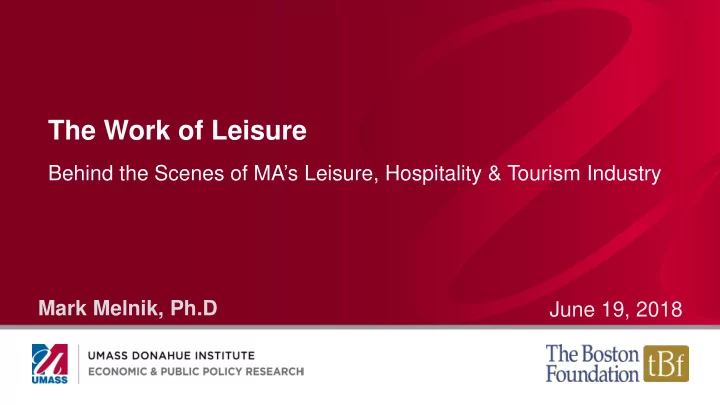

The Work of Leisure Behind the Scenes of MA’s Leisure, Hospitality & Tourism Industry Mark Melnik, Ph.D June 19, 2018
Presentation Overview • Leisure, Hospitality, and Tourism (LHT) industry overview • Issues and Trends • Why does it matter? • The current state of LHT in MA • Status and stature of the industry • Workforce considerations • Labor pipeline concerns for key occupations • Policy considerations 2
Why Study LHT? • Large industry with significant direct and spinoff effects in the economy • Industry leaders feel it is an overlooked sector • Significant challenges in workforce development and hiring 3
LHT Industry Definition & Subsectors Leisure, Hospitality, Amusements & Accommodation Recreation Tourism Museums & Heritage Food & Beverage Tourism Performing Arts, Spectator Sports, and Large-Scale Events 4
Key Takeaways 1. The significance of leisure, hospitality, and tourism (LHT) in the state’s economic portfolio is grossly overlooked LHT is the 3 rd largest industry in MA by size of workforce; employed 376,425 workers in • 2016 • The lion’s share of LHT workers are employed in the Food & Beverage subsector, followed by Amusements and Recreation, and then Accommodation • LHT has significant direct and spinoff effects in the economy • Supports a total of 608,000 jobs statewide • $69.4 billion economic activity • $52.5 billion in personal and disposable income 5
Source: U.S. Bureau of Labor Statistics, Quarterly Census of Employment and Wages; UMDI calculations 6
Source: U.S. Bureau of Labor Statistics, Quarterly Census of Employment and Wages; UMDI calculations 7
8
REMI Model Inputs and Outputs Direct Effects Ripple Effects Total Impacts 231,945 375,868 607,813 $41.18 (b) $28.22 (b) $69.4 (b) 9
Key Takeaways 1. The significance of leisure, hospitality, and tourism (LHT) in the state’s economic portfolio is grossly overlooked 2. The LHT workforce is among the most vulnerable and transient of any industry in the state • LHT workers are young • LHT workers have limited educational attainment • LHT workers are diverse • LHT has concentrations of Latino and foreign-born • LHT workforce earns less than other MA workers • LHT workforce has concentrations of poverty 10
Workforce Age Distribution, LHT vs Non-LHT 50% 45% 43% 42% 40% 35% 30% 30% 30% 25% 22% 20% 15% 15% 12% 10% 5% 3% 2% 1% 0% Under 19 20 to 34 35 to 54 55 to 69 70 and over LHT non-LHT Source: U.S. Census Bureau, 2012-2016 American Community Survey (ACS) 5-year estimates; UMDI calculations 11
Source: U.S. Census Bureau, 2012-2016 American Community Survey (ACS) 5-year estimates; UMDI calculations 12
Source: U.S. Census Bureau, 2012-2016 American Community Survey (ACS) 5-year estimates; UMDI calculations 13
Source: U.S. Census Bureau, 2012-2016 American Community Survey (ACS) 5-year estimates; UMDI calculations 14
Source: U.S. Bureau of Labor Statistics, Quarterly Census of Employment and Wages; UMDI calculations 15
Source: U.S. Census Bureau, 2012-2016 American Community Survey (ACS) 5-year estimates; UMDI calculations 16
Source: U.S. Census Bureau, 2012-2016 American Community Survey (ACS) 5-year estimates; UMDI calculations 17
Key Takeaways 1. The significance of leisure, hospitality, and tourism (LHT) in the state’s economic portfolio is grossly overlooked 2. The LHT workforce is among the most vulnerable and transient of any industry in the state 3. Despite being in a “low skill” industry, there are significant challenges in maintaining a well- skilled labor force • Of those LHT jobs projected to become available through 2019, the vast majority require a high school diploma or less, but these have high turnover rates • High skilled jobs requiring some formal training are primarily culinary, chefs and head cooks 18
19
How challenging is it to hire and retain appropriately skilled employees for the following job types? % Not a % Slightly % Very Challenge Challenging Challenging Management or Administration 11% 25% 64% “Front of the house” (customer-facing) 9% 25% 65% wage workers “Back of the house” wage workers 6% 24% 70% Equipment or operations workers 10% 23% 67% 20
Over the past five years, how challenging have the following issues been in maintaining a well-staffed, appropriately skilled workforce? 21
22
Policy Implication 1. Better align LHT workforce with cost of living, training, and recruitment challenges 2. Improve LHT marketing funds and strategy 3. Level the competitive playing field for LHT 4. Control rising costs of doing business in the LHT industry 23
UMass Donahue Institute Economic & Public Policy Research 100 Venture Way, Suite 9 Hadley, MA 01035 (413) 545-0001 mmelnik@donahue.umassp.edu www.donahue.umassp.edu 24
Recommend
More recommend